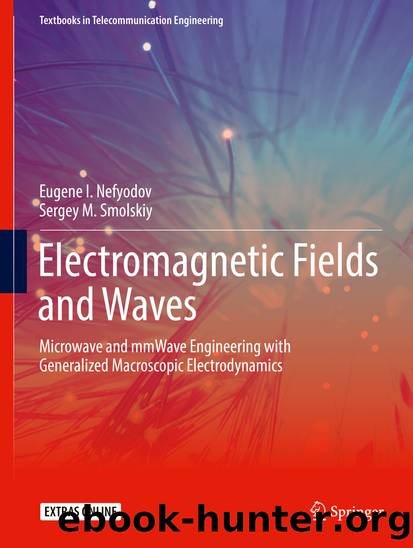Electromagnetic Fields and Waves by Eugene I. Nefyodov & Sergey M. Smolskiy

Author:Eugene I. Nefyodov & Sergey M. Smolskiy
Language: eng
Format: epub
ISBN: 9783319908472
Publisher: Springer International Publishing
The form of H10 wave presentation as in Eq. (6.47) is the required expansion of the waveguide representation (6.46) in the form of two plane uniform waves in Eq. (6.47), which propagate under the angle to z – axis of the waveguide (Fig. 6.21). Sometimes, these waves are referred to as partial.
From the expressions for E- and H-waves (besides, obviously, Hm0 and H0n waves) of any indices, we clearly see that each of these waves can be represented as a sum, not of two, but of four plane waves. Thus, the Brillouin approach (sometimes, Brillouin’s concept) is suitable for all waves of the rectangular waveguide. This situation is typical of other waveguides, although in much more complicated form. Thus, for a circular waveguide, we have an infinite number of plane waves (see Sect. 6.10).
In wide waveguides (ka ≫ 1, kb ≫ 1) a large number of waves can simultaneously propagate, which is approximately equal to N ≈ 2πab/λ2. All these waves, according to (6.24), have different speeds, and therefore, different times of arrival at the receiving end of the transmission line. This is the great problem at transmission of the wideband radio signal through the backbone communication link. It concerns to a lesser degree transmission lines used not for the radio signal, but for transmission of microwave and millimeter-wave power, when problems of electrical durability, etc., are considered first.
Download
This site does not store any files on its server. We only index and link to content provided by other sites. Please contact the content providers to delete copyright contents if any and email us, we'll remove relevant links or contents immediately.
| Antennas | Microwaves |
| Mobile & Wireless | Networks |
| Radar | Radio |
| Remote Sensing & GIS | Satellite |
| Signal Processing | Telephone Systems |
| Television & Video |
Whiskies Galore by Ian Buxton(40332)
Introduction to Aircraft Design (Cambridge Aerospace Series) by John P. Fielding(32338)
Small Unmanned Fixed-wing Aircraft Design by Andrew J. Keane Andras Sobester James P. Scanlan & András Sóbester & James P. Scanlan(32141)
Craft Beer for the Homebrewer by Michael Agnew(17446)
Turbulence by E. J. Noyes(7039)
The Complete Stick Figure Physics Tutorials by Allen Sarah(6638)
Kaplan MCAT General Chemistry Review by Kaplan(6054)
The Thirst by Nesbo Jo(5785)
Bad Blood by John Carreyrou(5769)
Learning SQL by Alan Beaulieu(5411)
Weapons of Math Destruction by Cathy O'Neil(5036)
Man-made Catastrophes and Risk Information Concealment by Dmitry Chernov & Didier Sornette(4736)
iGen by Jean M. Twenge(4702)
Digital Minimalism by Cal Newport;(4541)
Life 3.0: Being Human in the Age of Artificial Intelligence by Tegmark Max(4507)
Audition by Ryu Murakami(4099)
1,001 ASVAB Practice Questions For Dummies by Powers Rod(4038)
Electronic Devices & Circuits by Jacob Millman & Christos C. Halkias(4027)
Pale Blue Dot by Carl Sagan(4001)
